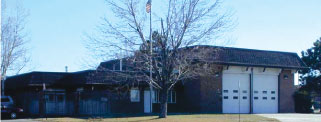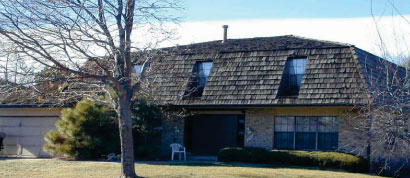Neo-Mansard
By the late 1960s, domestic architecture witnessed a shift away from the Modern influences and back toward styles based on traditional architectural shapes and detailing. The first form to emerge during this eclectic phase was the Neo-Mansard. Named for its characteristic roof form, the style bears little resemblance to the Second Empire style of the 1870s. Builders in the early 1960s realized that a relatively inexpensive way to obtain dramatic decorative effect was to construct a slightly sloping upper wall surface covered with wood shakes (or other decorative roofing materials). Unlike the Second Empire, where upper story windows were contained within dormers, Neo-Mansard properties had window openings cut through the lower slope of the mansard roof, forming a recessed window.

This Aurora fire station is a later example of Neo-Mansard form that lacks the double slope in the mansard roof.
The Neo-Mansard form was not confined to houses; it was also found on apartment houses, small commercial buildings and shopping centers. Its commercial application was often a new treatment (alteration) to an older building. This building type was most popular in the late 1960s and early 1970s, but has persisted through the 1980s with modifications. For example, windows that break through the cornice are common features on more recent buildings, but were rarely seen on early versions. Later examples usually lack the true double slope of the Mansard, appearing instead with a large pent roof projecting below a flat roof.
Common elements:
- Faux mansard roof
- Mansard is most often covered with wood shakes
- Recessed windows in mansard roof
- Often has mansard roof on more than one level
- Breakthrough cornice windows on later examples

